Search online for the Syderstone Ghost (Syderstone is a village near Fakenham in Norfolk) and you will find one strong connection. Look a little closer and you will come across a less well-known contender. Fortunately, Norfolk Record Office has you covered for both.
‘The Real Ghost’
A chance letter in 1957 (NRO, MC 5) led the Revd Fourdrinier on a quest to answer a century-old mystery. The letter asked him to throw some light on a series of unexplained events at the Parsonage detailed in an earlier letter sent over 100 years before. He went back to local newspaper articles from 1833, the first of which was titled ‘The Real Ghost’ (did they know something we don’t?), which had a strange and scary story to tell.
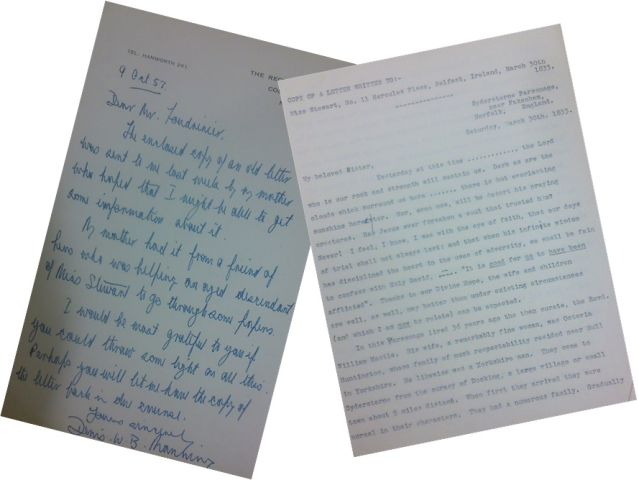
The letter that started it all
The original letter of 1833 came from Revd J. Stewart, the Rector of Syderstone at the time, around whom this story revolves, and concerns what he refers to as ‘the House of Mystery’.
This particular ghost had taken up residence at the local Parsonage, Stewart’s home at the time. It liked to move around (though nothing in the house was ever disturbed), and varied its activity such that ‘sometimes it was a low moaning which the Rev. says reminds him very much of the moans of a soldier on being whipped; and sometimes it is like the sounding of brass, the rattling of iron or the clashing of earthenware or glass’. The noises frightened the household to such an extent that ‘the maids … were actually incapable of motion’ and some of the staff were so scared they ran away.
The Revd opened his house to all and sundry, so they could satisfy themselves of the goings on, including no less than four local priests (Revd & Mrs Spurgin, Revds Goggs, Lloyd & Titlow) and a local surgeon, Mr Banks, on one particular night.
They were not disappointed, with a display that started ‘like the clawing of a voracious animal after its prey’ and included knocking, ‘some of which were as loud as those of a hammer on the anvil, lasted from between eleven and twelve o’clock until near two hours after sunrise’. One is quoted as saying ‘We had a variety of thoughts and explanations passing in our minds before we were on the spot, but we left it all equally bewildered’.
All those present on the night felt compelled to contact the paper, stating that their investigations, and subsequent independent examinations, were unable to find the cause, but the one thing on which they could all agree; this was not any kind of deception on the part of Revd Stewart or his family.
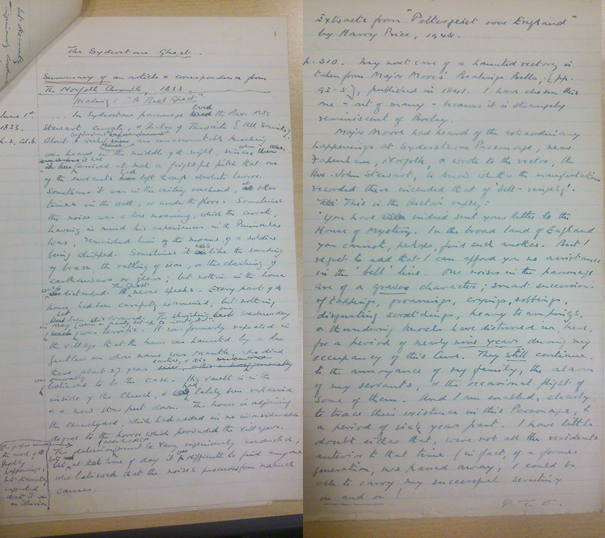
Revd Fourdrinier’s Notes
Revd Stewart was able to attribute the origin of his ghost to some 60 years previous, although ‘were not all the residents anterior to that time’ he would not have believed their story. The vicar 60 years earlier, Revd Mantle had been led into vice and drunkenness, having ‘formed an intimacy with a very dissipated circle of gentleman farmers’ one of whom had ‘an improper admiration of Mrs Mantle’ and ‘seduced the curate into the vilest debaucheries’. Indeed, Revd Mantle would have to be held upright during burial ceremonies ‘lest he should fall into the grave on top of the corpse’.
Needless to say, Revd Mantle died in a miserable state but, before being buried, ‘strange noises began to be heard in the parsonage’. It was these noises which greeted Revd Stewart and his family and, at the time these articles were written, ‘the ‘noises’ occasionally recur and my ‘diary’ occasionally progresses until it has, now, assumed rather a formidable appearance’.
‘Wail Bring the House Down’: The Curious Case of the Trip down the Stairs
The ‘wail’ in this case is that of Amy Dudley and the ‘House’ in question is that of the Tudor Dynasty. Amy was the daughter of wealthy gentleman-farmer Sir John Robsart and his wife, Elizabeth Scott, from Syderstone. She was the wife of Lord Robert Dudley, Master of the Horse to Queen Elizabeth I, and later Earl of Leicester – despite his family’s earlier attempts to install Lady Jane Grey on the English throne (NRO MC 5/33, 387×1, 387×2)
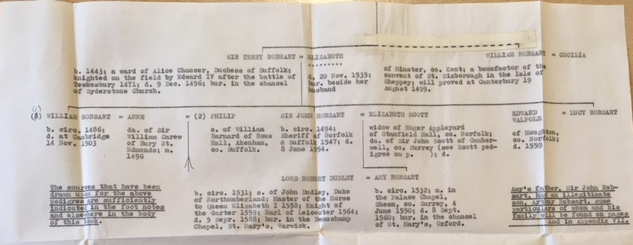
Amy’s Family Tree
Amy, having married Dudley shortly before her eighteenth birthday, did not follow him to court and therefore did not witness her husband become the favourite of the Queen. It was rumoured that Elizabeth would marry Dudley if he were free, a rumour strengthened by her unwillingness to marry beyond the point at which she was expected to tie the knot with one of her foreign suitors.
Not long before her death Amy moved from where she’d been living with friends to Cumnor Place, Abingdon, home of her husband’s treasurer. Rumours began immediately that ‘she had been moved there to be quietly poisoned – to be got rid of so her husband could marry the Queen’. These were even being reported back home by the Spanish Ambassador. Mistranslations of those despatches led to the false view that Amy had been a prisoner at Cumnor and that Elizabeth had told the Ambassador of Amy’s death before it happened.
So we come to the day of Abingdon Fair, on 8th September 1560. Amy went to some lengths to try and persuade the other ladies of the household to visit the fair and became quite agitated when some of them refused. Having later decided on a game of backgammon, she was subsequently found dead from a ‘fall from a pair of stairs’ with head injuries and a broken neck. The fact she had not been poisoned did not prevent the rumours that the Queen and Dudley had been behind what happened, and had it staged to look like an accident, even though both were at Windsor at the time.
Shortly after Amy’s death there were reports of ghostly activity in Syderstone Hall and that, when the Hall was demolished, the ghost moved to the nearby Parsonage, with many claiming Amy to be the ghost. She is the one strong connection as the identity of the ghost and the same Revd Fourdrinier later went on to write about her. His 1965 script (unpublished), in which he brings together all the available evidence surrounding Amy’s life and death, aims to draw a conclusion over the circumstances of her demise.
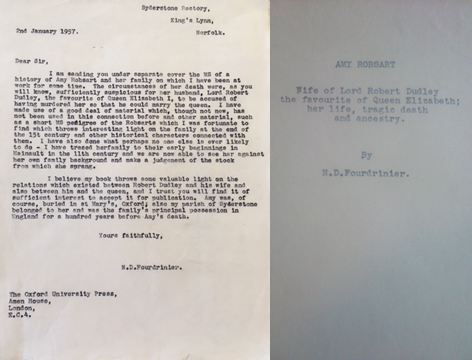
Frontispiece of Revd Fourdrinier’s Unpublished Book
Her death was officially ruled as an accident, though the furore surrounding the circumstances is believed to have given the Queen second thoughts over marrying Dudley – or anyone else. Unfortunately for Dudley, the attacks on him continued for the rest of his life. One, which appeared on the continent as an attempt to promote Mary, Queen of Scots, had the accusation that Amy was just one of many who were dispatched to further his own ends.
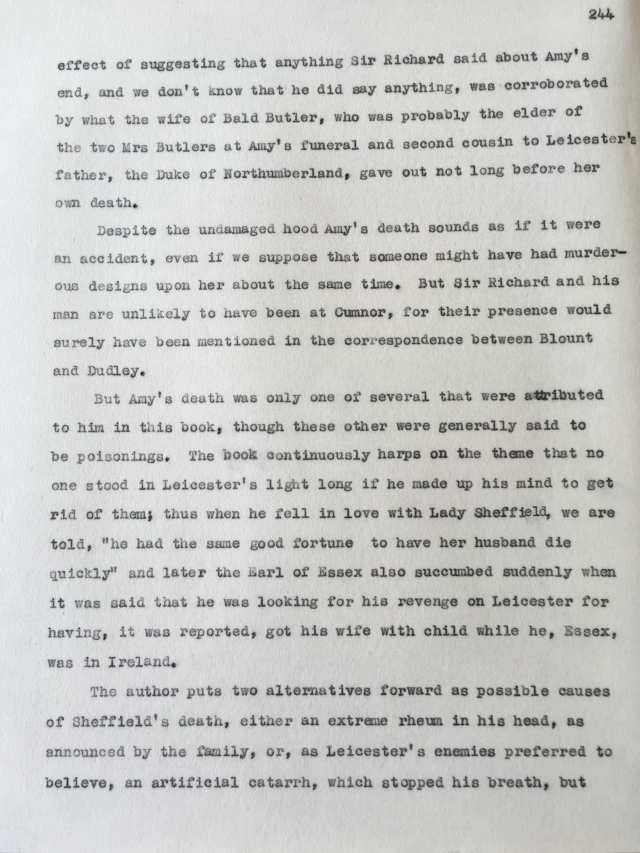
The accusations fly
Revd Fourdrinier, however, believes Amy’s health and lifestyle had a very big part in what happened, confirming ‘the likelihood of murder has been discounted by most good historians today, but, as already hinted, I find myself unable to accept the theory of suicide which is being put in its place’. According to him, modern doctors would have diagnosed Amy’s condition as an aortic aneurism, which causes, among other things:
- pains on the chest (of which Amy had complained)
- ischaemia (insufficient blood supply to the brain) which could have caused
- ‘irritability and touchiness, leading to fits of rage and being generally unreasonable’
- her to faint while coming down the stairs, accounting for the broken neck
- ‘a slight jerk or accidental fall, from a stool or doorstep even, is sufficient to burst it when death is instantaneous’
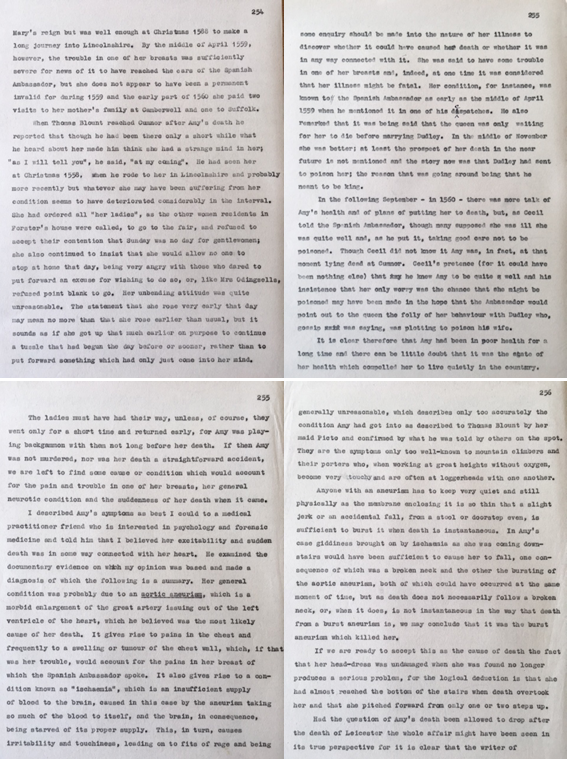
Amy’s health discussed
To quote Revd Fourdrinier, ‘Where Lies the Truth?’. Who IS the real Syderstone Ghost? Well, why not spend an afternoon in the Norfolk Record Office reading through the artefacts; then you can decide for yourself.
Compiled by Tim Ward, NRO research blogger.














Wonderfully written. The title is enough to arouse interest in the story. … Jumpyspiders . The name sounds like someone afraid of ghosts 😨
LikeLike
It’s a great title and a really interesting delve into the archives to try and find the answers.
LikeLike
Pingback: Which is the Real Syderstone Ghost? – Norfolk Tales & Myths
Appreciate thiss blog post
LikeLike
Thanks, Martin, glad you enjoyed it.
LikeLike